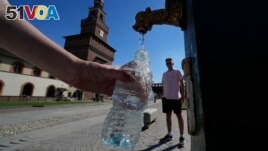17 January 2024
The average liter of bottled water has nearly a quarter million invisible pieces of very small plastic known as nanoplastics, a recent study says.
Researchers found the nanoplastics with a microscope using dual lasers.
Scientists long figured there were lots of these very small plastic pieces. But until researchers at Columbia and Rutgers universities did their calculations, they never knew how many or what kind.

FILE - Tourists fill plastic bottles with water from a public fountain at the Sforzesco Castle, in Milan, Italy, June 25, 2022. (AP Photo/Luca Bruno, File)
Looking at five samples each of three common bottled water brands, researchers found particle levels ranged from 110,000 to 400,000 per liter. The average was around 240,000, the study said. The research appeared recently in the publication Proceedings of the National Academy of Sciences.
Nanoparticles are particles that are less than a micron in size. In comparison, a human hair is about 83 microns wide.
Previous studies have looked at slightly bigger microplastics that range from 5 millimeters, which could be seen by human eyes, to one micron. About 10 to 100 times more nanoplastics than microplastics were discovered in bottled water, the study found.
Much of the plastic seems to be coming from the bottle and the filtration system to clean the water itself, said the study's lead writer Naixin Qian of Columbia University.
She would not name the three brands because researchers want more samples and they want to study more brands. Still, she said they were common and bought at a Walmart, a popular store in the U.S.
Researchers still cannot answer the big question: Are those nanoplastic pieces harmful to health?
"That's currently under review. We don't know if it's dangerous or how dangerous," said study co-writer Phoebe Stapleton of Rutgers University. "We do know that they are getting into the tissues (of mammals, including people) ... and the current research is looking at what they're doing in the cells."
The International Bottled Water Association said in a statement: "There currently is both a lack of standardized (measuring) methods and no scientific" agreement on the possible health effects of nano- and microplastic particles. The statement added, "Therefore, media reports about these particles in drinking water do nothing more than unnecessarily scare consumers."
The American Chemistry Council, which represents plastics manufacturers, declined to immediately comment.
The Associated Press spoke with four co-writers of the study. All of them said they would cut back on their bottled water use.
Columbia chemist Wei Min said he has reduced his bottled water use by half. Stapleton said she now depends more on filtered water at home in New Jersey.
But study co-author Beizhan Yan, a Columbia environmental chemist who increased his tap water usage, pointed out that filters themselves can be a problem by introducing plastics.
"There's just no win," Stapleton said.
Outside experts, who praised the study, agreed that there is a general unease about the risks of fine plastic particles. Still, it is too early to say anything certain about the risks.
"The danger of the plastics themselves is still an unanswered question. For me, the additives are the most concerning," said Jason Somarelli of Duke University in North Carolina. Somarelli was not part of the research. He added, "We and others have shown that these nanoplastics can be internalized into cells, and we know that nanoplastics carry all kinds of chemical additives that could cause cell stress, DNA damage and change metabolism or cell function."
Somarelli said his own research has found more than 100 "known cancer-causing chemicals in these plastics."
Dual laser microscope
About 15 years ago, Min invented dual laser microscope technology that identifies specific compounds by their chemical properties and how they respond when exposed to lasers. Yan and Qian talked to him about using that technique to find and identify plastics that had been too small for researchers using established methods.
Kara Lavender Law of the Sea Education Association said "the work can be an important advance in the detection of nanoplastics," but she said she'd like to see other chemists use the technique and get the same results.
Yan said he is starting to study water supplies in the U.S. cities of Boston, St. Louis, Los Angeles and elsewhere to see how much plastics are in their tap water. Previous studies looking for microplastics and some early tests suggest there may be less nanoplastic in tap water than in bottled water.
Even with unknowns about human health, Yan said he does have one suggestion: Use reusable bottles instead of single-use plastics.
I'm John Russell.
And I'm Ashley Thompson.
Seth Borenstein reported on this story for the Associated Press. John Russell adapted it for VOA Learning English.
________________________________________
Words in This Story
sample – n. an amount of something that gives you information about the thing it was taken from
brand -- n. a category of products that are all made by a particular company
review -- v. to look at or examine (something) carefully especially before making a decision or judgment
standardize – v. to change (things) so that they are similar and consistent
tap water – n. water that comes through pipes from the public water system
internalize -- v. to absorb or take in
metabolism -- n. the chemical processes by which a plant or an animal uses food or water to make energy
detect -- v. to discover or notice the presence of something